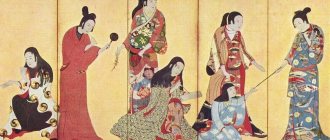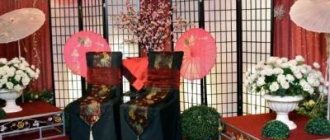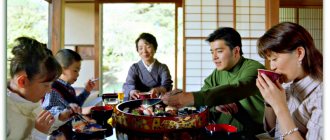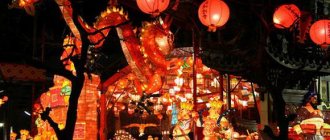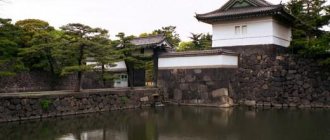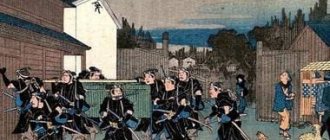| « | The samurai ate rice and drank tea. A bloody sunrise lit up. The samurai will shout loudly “Banzai!” And he will go on an endless journey. | » |
| — Song from the repertoire of Angelika Varum | ||
| « | Once upon a time there lived a samurai, kind and attentive. Every day he sent Ikebana to his mother. | » |
| — Folk | ||
| « | That night the samurai decided... | » |
| — Invisible verse from the song “Three Tankers” | ||
The most important thing to remember about samurai is that the verb "samurau" means "to serve." It all comes down to this. If the European nobility proudly called themselves nobleman, Edelmann, gentilhomme, that is, “well-born, noble,” then the samurai for a long time were sharply separated from the kuge
(ancestral nobility) and looked at them as kuso. They are much closer in origin to the Russian nobleman, the German hofmann or minesterial and the English yeoman. Unknown, but obliged to serve.
Of course, over time, samurai clans and families acquired their own pedigrees. But still, coming from kuge, or at least becoming related to them, was cool, but coming from a purely samurai family was not so much. The very pinnacle of samurai power is the title (originally the position) of shogun, formally the supreme commander-in-chief of the country's armed forces. It so happened that all the famous shoguns came from the Minamoto clan, and he was very strongly associated in the minds of the Japanese with this clan. For example, Oda Nobunaga, with all his power, did not claim the position of shogun - perhaps because he did not come from the Minamoto clan, perhaps because of his eccentricity, perhaps he simply wanted to unite the country first. Even Toyotomi Hideyoshi, despite his absolute and sole power in the country, was afraid to claim this title. But Tokugawa Ieyasu, although the seventh water on jelly, is still Minamoto, [1] that’s why he became shogun.
The family of Oda Nobunaga originates from the Taira clan - descendants of Emperor Saga, and in terms of nobility he was not particularly inferior to the Minamoto family, but became the owner of the rare title of buke no toryo
. The story of Ise Shinkuro is interesting. He was a distant descendant of the Taira clan, but his family had the status of just a hatamoto. Thanks to betrayals and diplomatic and military talents, he was able to capture the province of Izu and proclaimed himself a descendant of the powerful Hojo clan (the real Hojo also came from Taira, but from a completely different branch of it). Only his son, by marrying the only surviving woman from the Hojo family (a widow 10 years older than him) and rich gifts to the shogun and imperial court, managed to achieve recognition of his right to this surname with difficulty. Among historians, these intermarried with Hojo are usually called Go-Hojo (literally “Hojo-Two”).
onna-bugeisha
- women from the samurai class - from childhood they were trained in the use of weapons and, no worse than men, could protect the house and defend the honor of the family. And most often, the glory of heroes was gained by those from the class whose income allowed them to become horse archers. And due to their income level and social status, they wore the best expensive armor.
Female samurai
Women Samurai
When we say the word “samurai”, the image of a man immediately comes to mind, however, in ancient Japanese chronicles there are many references to women samurai, who were called onna-bugeisha. Women and samurai girls took part in bloody battles along with the stronger sex. The naginata (samurai long sword) was the weapon they used most often. An ancient Japanese bladed weapon with a long handle (about 2 meters) had a curved blade with a one-sided sharpening (about 30 centimeters long), almost an analogue of a melee bladed weapon - a glaive.
There are practically no mentions of female samurai in historical chronicles, which is why historians assumed that there were very few of them, but the latest research into historical chronicles has shown that onna-bugeisha contributed to battles much more often than is commonly believed. In 1580, a battle took place in the town of Senbon Matsubaru. According to the results of excavations, out of 105 bodies discovered at the battle site, according to the results of the DNA analysis, 35 belonged to the female sex. Excavations at other sites of ancient battles have yielded approximately the same results.
Symbols
In China there is a dragon: The Chinese dragon differs from the European one in its wisdom. In total, nine types of dragons “live” in China: heavenly, spiritual, underground, treasure dragon, winged, water-living dragon, horned, yellow, which came from the Lo River in order to teach other creatures to write, and royal.
In Japan - sakura: This is the national symbol of the country. The Japanese, watching the cherry blossoms, philosophize that beauty does not last forever.
Samurai armor
Samurai armor
Unlike the knightly armor of medieval Europe, samurai armor was created with mobility in mind; it must be very strong, but at the same time remain flexible enough so as not to restrict the warrior’s movements. Samurai armor was made of metal or durable leather plates coated with varnish. The plates were neatly tied together with leather laces. The hands were protected by shoulder pads - small rectangular shields, as well as armored sleeves.
An interesting detail of a samurai's armor is a bowl-shaped helmet, assembled from metal plates fastened together with rivets. The face was protected by armor attached to the back of the head, under the helmet. An interesting detail of the samurai headdress is the balaclava, which is very reminiscent of Darth Vader’s mask (an interesting fact is that the design of the shape of the helmet of the Star Wars movie character Darth Vader was taken from the shape of the helmet of the Japanese samurai). This piece of armor protected them from blows from arrows and swords delivered at slight angles. Masks of combat masks - mengu - were attached to the helmet, protecting the warrior and frightening the enemy.
Afro Samurai!
An African, presumably from Mozambique, arrived on the islands in 1579 as a servant of the Italian Jesuit Valignano. The unusual appearance attracted the attention of the unifier of Japan and lover of foreign wonders Oda Nobunaga, who tried to become a gaijin. Huge by Japanese standards, “strong as ten men,” and a brave African, he entered Nobunaga’s service and became one of his bodyguards. He showed himself worthily on the battlefields and two years later received samurai dignity, an estate, and the name Yasuke - the real one was lost in the darkness of centuries. Yasuke defended the Honnouji Temple from the troops of the traitor Mitsuhide, but the forces were unequal, Oda Nobunaga died. The African broke through to the positions of the overlord's son, Oda Nobutada, but he was also defeated at Nijo Castle and forced to seppuk. Yasuke survived the fall of the Oda house: the victors sent him to the Jesuits.
Zamecki
Hollywood, of course, could not ignore such a story, and now we are talking about the production of the film “Yasuke - the Black Samurai” with a budget of 4 million dollars.
Sex and samurai
Sex and samurai
Sexual relationships between Japanese warriors can be called free. Approximately the same relationships took place in ancient Sparta. Same-sex relationships typically arose between more experienced samurai masters (mentors) and young warriors who were just beginning to train (novices). This practice of same-sex relationships was called wakashudo (the way of youth). Documentary evidence found suggests that almost the entire samurai class passed through the “path of youth.”
European samurai
Ancient Japanese chronicles say that under special conditions, a non-Japanese person could easily fight alongside the samurai, and becoming one of the samurai was considered a special honor. Such a warrior was given weapons and armor, and was also called a new name, Japanese. This honor could only be bestowed by very powerful leaders, such as the daimyo, or by the person who actually ruled Japan for most of the time - the general, that is, the shogun.
In history there is a mention of four men who had the honor of receiving the title of samurai:
The English navigator and the first Briton to reach the shores of Japan, William Adams, also known as Miura Anjin, played a vital role in the development of trade relations between Japan and Holland and Japan and England.
Dutch navigator and merchant Jan Joosten van Lodestein, known as Yayosu, acted as adviser to the shogun Tokugawa Ieyasu on foreign policy and trade issues.
French naval officer Eugene Collache also took the title of samurai. Japanese name unknown. Upon arrival in France, he was dismissed by court martial as a deserter. He wrote the book Adventures in Japan 1868-1869, which was published in 1874.
Dutch by birth and arms dealer Edward Schnell, Japanese name Hiramatsu Buhei. He was a military instructor and weapons supplier for the Japanese.
Martial arts
In China - Wushu and Kungfu: Wushu is a gymnastics that combines all types of martial arts. Kungfu in China is any type of activity in which you can improve, no matter whether it is martial arts or drawing.
In Japan - sumo, judo, aikido, karate, jiu-jitsu: If in China the main thing in martial arts is self-improvement, then in Japan it is killing an opponent. And bu-jutsu is the basis of all martial arts.
Number of samurai
There is an opinion that samurai were chosen warriors and there were very few of them. In reality, samurai were armed servants close to the nobility. Subsequently, samurai became associated with the bushi class - middle and upper class warriors. A simple conclusion suggests itself - there were significantly more samurai than is commonly believed; more than 10% of the Japanese population were samurai. And since there were many of them, they had a significant influence on the history of the empire; It is believed that today every Japanese has a piece of the blood of great warriors.
Sengoku (1467–1603)[edit]
A typical film image of a samurai is often a former peasant son who managed to curry favor and become a samurai, thanks to the endless war of all against all. He may not even be able to read.
To a greater extent, this is a hyperbolic exaggeration characteristic of oriental cinema. In reality, this was a relatively rare occurrence, since during the Sengoku era a vast ashigaru class was formed, intermediate between the samurai and the other population. Its representatives often, having curried favor, bought land or became artisans and merchants, and their younger sons again went to ashigaru (90% of the figures of the Sengoku era, who are credited with origins from ordinary peasants and townspeople, are exactly like this). Therefore, they knew well the life and culture of the samurai class and were literate. In Japan at that time, often even women not from the nobility and not from the kuge were by no means illiterate.
Speaking of ashigaru. Initially, these were militias recruited by Japanese feudal lords from their own peasants, who received their name - “light-footed” - because they were not burdened with armor: the average ashigaru had only an iron hat to protect against arrows and, at best, light leather armor, and was armed with what sent by gods and buddhas, usually with a yari spear or, later, an arquebus.[2] At the height of Sengoku, the ashigaru often included gangs of village daredevils who were not subordinate to anyone, always hanging out around the combat zone on the issue of plunder, fortunately, they, as a rule, were not at all against hiring one of the opponents, thus raising their status and avoiding bullies for looting, as well as local self-defense units created by village elders to protect them from swarming bandits, and, in fact, the bandits themselves, if they already
weren't ronin anyway.
At the end of the era, the ashigaru class became more and more hereditary and almost completely merged with the lower stratum of provincial samurai, many of whom, due to the extreme lack of maintenance (samurai in general, as a rule, did not have land and lived on salaries, and not on land rent, like European nobles) were forced to earn their living themselves, either by cultivating the land or by engaging in trade and crafts. At the end of Sengoku, a reshuffle of the service classes was carried out, [3] during which the ashigaru class was virtually eliminated - the more prosperous were considered samurai, and those who were poorer - along with the poorest samurai, from those who lived by their own labor, [4] became be considered commoners. The very word “ashigaru” began to mean simply a samurai infantryman, this time often already quite armored.
On the one hand, this was the heyday of the military class and the opportunity to rise from rags to riches. On the other hand, the actions of the samurai very often ran counter to the later code of Bushido[5]. Betrayal and murder of the overlord, robberies and violence against civilians were commonplace. And even disrespect for Buddhist and Shinto shrines - Christianity spread quite widely in the southern Japanese principalities, and the local population in some places even organized pogroms of local Buddhist and Shinto monasteries and shrines, allegedly even going so far as to capture and sell into slavery their monks[6] and priests with the tacit approval of local Christian daimyo[7].
Samurai clothing
Samurai clothing
Samurai were, in a sense, standards, and the style of their clothing had a significant influence on the fashion of an entire era. Samurai almost never dressed outrageously. All of their clothing was designed to fit the needs of a warrior. It was intended for freedom of movement and should not restrict movement.
The samurai's clothing consisted of several basic elements: hakama (wide trousers, similar to bloomers), kimono (traditional clothing in Japan, usually silk), and hitatare (a kind of cape, ceremonial clothing that was worn under armor). This suit did not restrict movement and left your hands free. For footwear, samurai wore boots made of wood and simple sandals.
Perhaps the most characteristic feature was the samurai's hairstyle - hair collected in a bun. This may be due to the fact that wearing a helmet with this hairstyle is more convenient.
Religion
In China - Confucianism / Taoism / Buddhism: One person can profess several religions at once.
In Japan - Shintoism
The Japanese believe that everything around them has a soul, they also believe in magic, totemism (the reverence of individual animals) and fetishism (the belief in the supernatural power of amulets and talismans).
Samurai weapon
Samurai Weapons
Being warriors, samurai were fluent in many types of weapons. The oldest sword they carried was the chokuto sword. This was the name of all ancient type swords that appeared in Japan in the 2nd-4th centuries AD. They were straight and had a one-sided sharpening.
The weapons continued to be improved. Subsequently, the swords became more curved and over time turned into the legendary Japanese sword, known to us as the katana - a curved Japanese two-handed sword with a single-sided blade and a blade length of more than 60 centimeters. Without a doubt, the Japanese katana sword is a symbol of the samurai, because, as the samurai code says, the soul of a warrior lives in his sword. Along with the katana, the samurai carried a smaller sword - the shoto, 33-66 centimeters long. Only samurai had the right to wear shoto. Together, the large and small swords were called daisho, which literally translates as “big-small.”
The samurai also had a long bow in his arsenal - yumi, more than two meters long. The bow is made from laminated bamboo, wood, and leather is also used in the work; this manufacturing method has not changed for centuries. The samurai practiced archery almost to the point of fanaticism. Also in battle, Japanese warriors used a spear - a yari, a Japanese polearm with many modifications. But for the samurai, the spear was, for the most part, a symbol of personal courage.
Before the Gempei War[edit]
Age of Asuka (538-710) and Nara (710-794)[edit]
This is the time of collapse of the traditional tribal system. The last waves of migrations from the Korean Peninsula to Japan were still underway, the state of Yamato covered only the south of the present island of Honshu, the island of Kyushu was completely inhabited by the Hayato and Kumaso barbarians, the north and center of Honshu were inhabited by the Ainu. Tribal relations dominated in Yamato - all government and religious positions were hereditary within any one clan, the imperial family was forced to share power with the 1-2 most powerful clans (for example, Soga, Mononobe, Nakatomi). The nobility and aristocracy have not yet completely separated into separate classes. During the Asuka era there was a powerful cultural and religious influence of China on Yamato - Buddhism and Confucianism penetrated. At the end of the Asuka era, Prince Nakano and Kamatari Nakatomi carried out a series of reforms that broke the remnants of the tribal system and formally removed the clan from governing the country. De jure, a state system was introduced according to the Chinese model; de facto, all power passed to the Fujiwara surname (this surname was assigned to Katamari from the old Nakatomi family) and their associates. It was their descendants who became the core of the emerging Kuge class. Instead of the previous clan militias, military service was introduced for several years for one adult man from each family.
Heian era (794-1185)[edit]
For most of the Heian era, power in the country was usurped by various branches of the monstrously expanded Fujiwara family. Power and influence began to be determined by position and intrigue at the imperial court. From generation to generation, yesterday's rude leaders of clans and clans turned into sophisticated aesthetes and connoisseurs of the arts. The aristocrats increasingly neglected the affairs of governing the country, and even appointed provincial governors became the norm not to leave Heian for decades. Under the influence of the Confucian worldview and Buddhism, military people began to be looked upon as inferior, and now they were even prohibited from entering the capital without carrying out purification ceremonies! Court gentlemen still carried a sword, but it was considered good form not to know at all from which end they were taking it (increasingly, even swords became decorative crafts or even props). Future samurai were considered rude and rude martinets.
But there was unrest in the northern provinces, and in the southern ones too. Actually, there was unrest throughout the country, and even outside the then capital itself. Literally half a day away from the city walls - as you see: either a robber, or a lawless monk, or some other bastard, and often all at once in gangs of several hundred blades! Those who lost in court intrigues and even those who simply displeased Fujiwara were henceforth sent to the provinces on military assignments. Therefore, the aristocrats who were sent to serve in the provinces, like it or not, learned to fight. The Fujiwara clan saw dangerous competitors for power in representatives of the Minamoto and Taira clans (they descended from the youngest sons of the emperors) and tried with all their might to keep them away from the capital. Of course, formally they were still considered kuge - noble aristocrats - but the further they went, the more in their way of life they became real hereditary military men, and the capital's slackers despised them.
For their part, Minamoto and Taira tried to recruit more or less permanent squads and military detachments of people personally loyal to them, and the reflection of their noble origin fell on yesterday’s peasant-robber-barbarians who were under their power. The further their service went, the more it became hereditary and associated with one or another branch of the Minamoto-Taira. It was on them that the entire burden of fighting barbarians, maintaining order in the provinces, fighting rebels and robbers, and collecting taxes fell. At first, they obeyed orders from the capital, participated in intrigues and internecine wars of various branches of the Fujiwara clan between themselves and the imperial family.
The southern and northern borders of the Yamato state were a dynamic and rapidly developing frontier, military detachments cleared these lands from the Emishi-Hayate barbarians, and after them these lands were populated by peasants fleeing from the exorbitant taxes and duties of already civilized lands. Yesterday's fortified military camps grew into large cities-capitals of new provinces, formally aristocrats-kuge were appointed as governors, but more often they preferred permanent participation in the interesting and sophisticated life of the court, and all affairs were managed on their behalf by military governors, most often from the Taira and Minamoto families , as well as the guilty and collateral offspring of the Fujiwara and Tachibana clans. This is precisely why the vast majority of future daimyos trace their genealogy back to them. Gradually, these Taira and Minamoto began to send less and less income to the capital and increasingly ignored orders from the capital. Their warriors received land for their service, but were obliged to appear equipped for war upon request. It was they who were first given the nickname samurai.
In the end, Taira no Kiyomori brought troops into the capital and removed the Fujiwara clan from power, married his daughter to the emperor and became the de facto ruler of the country. True, to do this he had to cut out his own uncle and a significant part of the Minamoto family.
A few years later, Taira died, and the under-spent Minamoto rebelled and carried out a retaliatory genocide against Taira. About the sad fate of the Taira clan and the Gempei
(1180-85) can be read in The Tale of the House of Taira. The main thing to remember is that after the Gempei War, Japan changed forever. The imperial court, having lost authority, military strength and sources of income, hopelessly turned into pure decoration, and samurai began to rule the country.
Samurai image
The armor and weapons of the samurai created a rather impressive appearance, and now in many films Japanese warriors are shown just like that. In reality, everything was not like that. Their height in medieval Japan was approximately 160-165 centimeters, and their physique was thin. In addition, there are many references that it is likely that samurai descended from an ethnic group of the small Ainu people. They were much taller and stronger than the Japanese, their skin was white, and their appearance was largely the same as the Europeans.
Meiji (1868-1912), Taisho (1912-26) and Showa (part of 1926-45, including World War II)[edit]
Although the samurai as a class was disbanded during the Meiji Revolution, the samurai spirit still lives and is used with might and main in Japanese propaganda. After all, we must raise cannon fodder who are ready to die for the emperor and the great Yamato. In Soviet propaganda during the times of Hassan, Khalkhin Gol and the Great Patriotic War, the meaning is the same, but here the samurai are evil officers who unquestioningly serve the imperialist emperor and the bourgeoisie (“That night the samurai decided / To cross the border by the river...”). And in American propaganda of the same years, they are generally bloodthirsty monsters who need to be
destroy. The Japanese themselves fully contributed to this image.
On the other hand, at least in relation to the Great Powers (the Chinese and Koreans are a separate conversation), in the Meiji era the Japanese tried in every possible way to observe politeness and generally accepted customs - first of all, so that they would be considered civilized people by Europeans. During the Russo-Japanese and First World Wars, Japanese soldiers, on the contrary, were considered perhaps the most correct and courteous in the world. However, starting from about the middle of the Taisho era, the military elite began to develop the opinion, inflated by some nationalist philosophers, that the Japanese, as the descendants of the gods, were by definition better than everyone, which means “down with shame” - and the province began to dance... However, until Pearl Harbor, when the war took place only in China, without affecting the European colonies in Asia, the Japanese continued to behave with the Europeans and Americans in an emphatically polite manner, without any embarrassment towards the Chinese.
Harakiri
Harakiri
Ritual suicide by cutting open the abdomen - seppuku or harakiri - is an immediate attribute of the samurai. Seppuku was committed at a time when the samurai was unable to follow the code of bushido, or when he was captured by an enemy. Ritual suicide was not only done voluntarily, but was also used as punishment, but in any case it was an honorable way to die.
The ritual of seppuku is a fairly lengthy ritual. It began with a washing ceremony. After bathing, the warrior was dressed in all white and brought his favorite food. Immediately after eating, a short sword was placed on the already empty dish. Next, the samurai wrote a dying poem - tanka (a five-line Japanese poetic form consisting of 31 syllables). After this, the samurai took a short sword, wrapped the blade in cloth so as not to cut his hand, and committed suicide by cutting his stomach.
The person nearby had to finish off the samurai by cutting off his head. In most cases it was the closest friend who was given the greatest honor and was given an honorable role. The assistant's greatest skill was to cut off the head so that it hung on a small strip of skin and remained in the arms of the already dead samurai.
Edo (1603-1868) and Bakumatsu (1853-69)[edit]
The typical film image is even poorer than the typical nobleman in European literature, often has nothing in his soul except his sword, and sometimes even, due to extreme poverty, shyly carries a wooden sword in an empty scabbard (with which he is nevertheless capable of beating a less skilled swordsman , armed with a real sword). At the same time, he is able to appreciate beauty and is not averse to writing a haiku or two in his spare time.
This is the era of extinction and degradation of the samurai class. The vast majority of samurai (except daimyo) were deprived of the right to own land and at the same time they were prohibited from engaging in anything other than military affairs, while they made up 10-15% of the country's population. But for 10 generations, Japan did not conduct any military operations, and the majority of the population looked at the samurai as beggars and idlers. In the 18th century The daimyo's income fell sharply, as the expanding merchant class, with its speculation, sharply brought down the price of rice. In addition, due to constant crop failures and price hikes, famine began in the country, and the clumsy actions of the government (for example, one of the shoguns, in an attempt to regulate the exchange rate of the gold ryo, tried to buy back all the gold
in the country) caused a permanent economic crisis.
Suffice it to say that in 1700-1850. the population almost did not grow and even mass killings of children during the famine years became the norm. In this regard, under various pretexts, the majority of samurai had their contents sharply reduced; often, under far-fetched pretexts, they were simply expelled, and more often they were actually forced to become ronin, giving them purely symbolic content. This led to a huge increase in the number of ronin, mass suicides of samurai spread (in some years their number reached 20 thousand per year or more). The plot of the legend and the film “Forty-Seven Ronin” would have been impossible, for example, in the Sengoku era.
A huge number of ronin joined the ranks of criminals (they influenced the traditions of the yakuza), settled in cities and began to engage in crafts or trade (this was quite dangerous, since Tokugawa Japan was a terrible police state, and it was not easy to disappear into the cities unnoticed). Many samurai (especially in southern Japan) engaged in trade and speculation through front men. Actually, this flourished with might and main in the Sengoku era, but if at that time such training was widespread in the poor provinces, then in the Edo era samurai became massively impoverished even in the capitals. It got to the point that even hatamotos became merchants and artisans (through dummies, or simply by intermarriage with the respective families)!
At the same time, the government tried its best to implement the “Buke sho hatto” Code of Samurai Clan, created under the influence of the earlier unwritten code of Bushido. Even a daimyo could be severely punished for not following his letter and spirit:
- A samurai was forbidden to lie at all, especially in front of witnesses. On the one hand, the word of each samurai had to always be taken on faith (for example, in court), on the other hand, if he was caught in deception, both he and his family were severely punished for several generations.
- A samurai must always be in combat readiness and able to repel attackers. This applies to any
samurai who has undergone the coming of age rite. There are known cases when daimyo and major officials were deprived of their status with the wording “for the fact that, being a samurai, he could not protect his family / fight back”; they were sometimes even executed for this. - The necessity of carrying weapons was a direct consequence of this. His loss under any
circumstances was considered the samurai's fault. - In Japanese traditions, drawing a weapon is completely unacceptable - it is not even considered a threat, but the very fact of an attack. Therefore, if a samurai was killed while trying to expose him first, then the killer was supposed to be acquitted in court.
